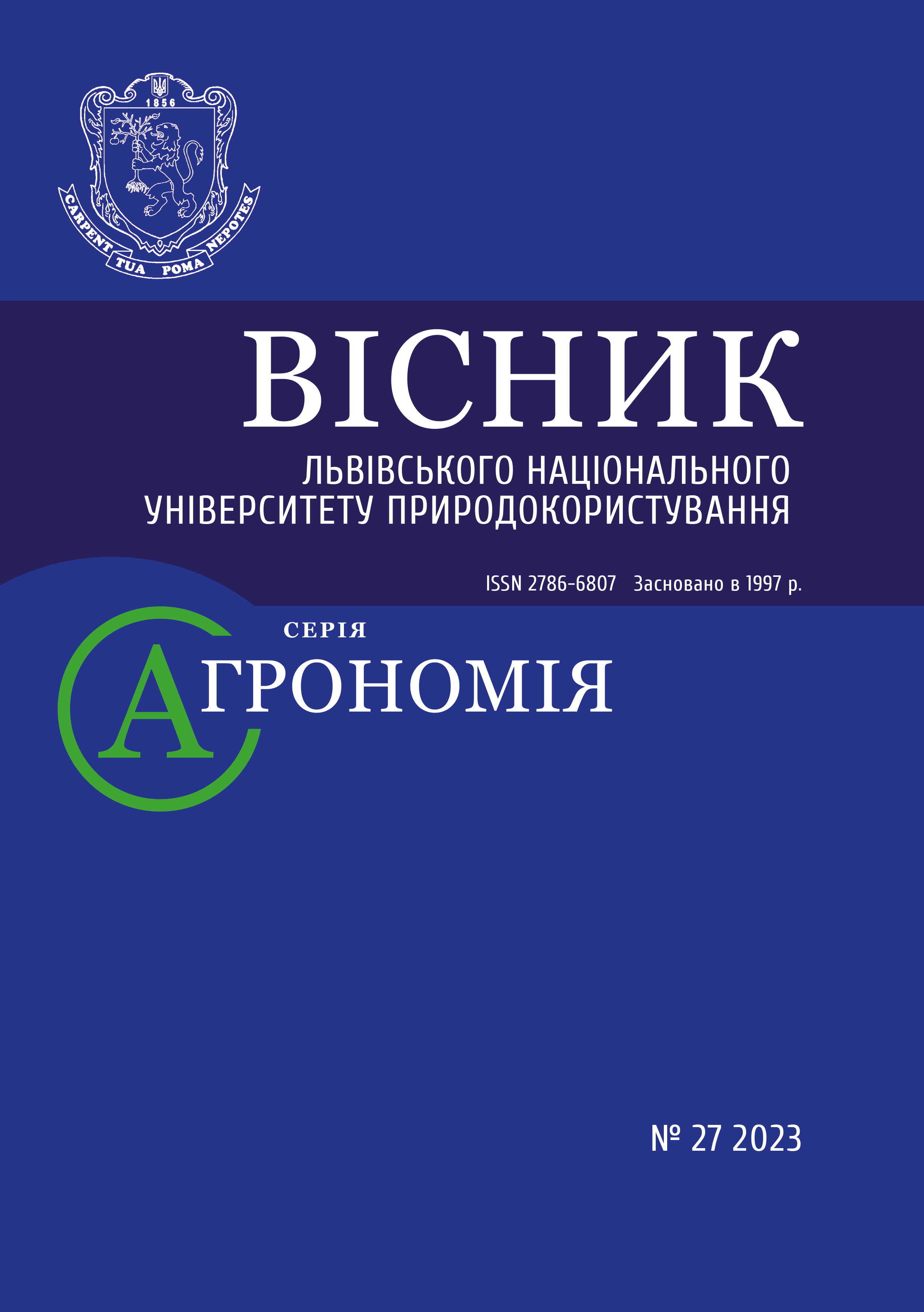Глобальне потепління і малий кругообіг: ризики та перспективи
DOI:
https://doi.org/10.31734/agronomy2023.27.058Ключові слова:
кліматичні зміни, ґрунт, ландшафт, рослинність, кругообіг водиАнотація
Зміна клімату змінює наше розуміння нас самих, нашого суспільства, взаємозв’язків
між соціально-економічними та біофізичними системами й місця людства на Землі.
Зрозуміло, що Земля нагрівається, але науковий консенсус пів століття ігнорував
першопричину цього загрозливого явища, тож відповідь була неефективною й не
спричинила консолідації зусиль. Зауважено, що основними причинами впливу на клімат в
агросекторі є розчищення земель для сільського господарства, позбавлення цілорічного
покриття ґрунту рослинністю, зменшення лісів, унаслідок чого голий ґрунт стає відкритим
для сонячного випромінювання, створюючи відчутне тепло. Обмежується або припиняється
ефект охолодження від випаровування рослинністю. Це суттєво змінює надходження й
переміщення вологи в тропосфері, припиняє переміщення вологих повітряних мас вглиб
сухих територій. Визначено найважливіші напрями та деякі дії для вирішення проблеми
оголених ґрунтових поверхонь.
Земля досі намагається зберегти найсприятливіше середовище для всього живого.
Отже, найбільш безпечне і стале землекористування має імітувати природний рослинний
покрив. Фермерам та іншим землекористувачам потрібно уникати перебування оголеного
ґрунту під сонячним промінням. Для досягнення цієї мети запропоновано: мінімізувати
обробіток, відмовившись від оранки плугом; впровадити різноманітні сівозміни, головно з
багаторічними культурами; формувати строкатий, різноманітний ландшафт, який сприяє
малому кругообігу води в агроекосистемах. Визначено лише деякі процеси, через які
оголений або неоголений ландшафт впливає на погоду та клімат. Доведено, що вплив
оголення ґрунту від рослинності на атмосферні процеси потрібно враховувати в політиці
регіонального землеустрою в агроландшафтах у всьому світі, і навіть там, де значне
розчищення землі для сільськогосподарських цілей неможливе.
Посилання
150 years of Vernadsky, the Noösphere: vol 2. / eds J. A. Ross and M. K. Rouillard. Scotts Valley CA: CreateSpace, 2014. 84 p.
Adegoke J. O., Pielke R. A., Carleton A. M. Observational and modelling studies of the impacts of agriculture-related land use change on planetary boundary layer processes in the Central U.S. Agricultural and Forest Meteorology. 2007. No 142 (2–4). Р. 203–215.
Bellamy D. Where have all the trees gone? Bellamy on Botany. London: BBC, 1972. Р. 48–57.
Climate change and land: an IPCC special report / Shukla P. R. and others. Geneva: IPCC, 2019. 846 р.
Climate variability and change in south west Western Australia / report of Indian Ocean Clim. Initiative, East Perth: IOCI Panel, 2002. 43 p.
Crews T. E., Carton W., Olsson L. Is the future of agriculture perennial? Imperatives and opportunities to reinvent agriculture by shifting from annual monocultures to perennial polycultures. Global Sustainability. 2018. No 1 (11). Р. 1–18.
Dent D. L., Boincean B. P., Bai Zh. An investable proposal to transform the steppe. Soils under stress. More work for soil science in Ukraine / eds. Y. Dmytruk & D. L. Dent. Cham : Springer, 2021. Р. 27–34.
Huang X., Lyons T. J., Smith R. C. G. The meteorological impact of replacing native perennial vegetation with annual agricultural species. Hydrol. Processes. 1995. No 9. P. 645–654. doi:10.1002/hyp.3360090512.
Kala J., Lyons T. J., Nair U. S. Numeral simulations of the impact of land-cover change on cold fronts in south-west Western Australia. Boundary Layer Meteorol. 2011. No 138. P. 121–138. doi:10.1007/s10546-010-9547-3.
Keeling C. D. The concentration and isotopic abundance of carbon dioxide in the atmosphere: Tellus. 1960. No 12 (2). Р. 200–203.
Lovelock J. E. Gaia. The practical science of planetary medicine. London: Gaia Books, 1991. 192 p.
Lovelock J. E. Gaia: a new look at life on the Earth. Oxford: OUP, 1979. 176 p.
Lyons T., Smith R., Xinmei H. The impact of clearing for agriculture on the surface energy budget. International Journal of Climatology. 1996. No 16. Р. 551–558.
Lyons T. J. Clouds prefer native vegetation, Meteorol. Atmos. Phys. 2002. No 80. P. 131–140. doi:10.1007/s007030200020.
Mulvey P., Mulvey F. Ground breaking. Soil security and climate change. Melbourne : Kerr Publishing, 2021. 190 p.
Nair U. S., Wu J., Kala J. and others. The role of land use change on the development and evolution of the west coast trough, convective clouds and precipitation in southwest Australia. Journal of Geophysical Research. 2011. No 116. doi: 10.1029/2010JDOI014950.
Narisma, G. T., Pitman A. J. The impact of 200 years of land cover change on the Australian near-surface climate. J. Hydrometeorol. 2003. No 4. P. 424–436. doi:10.1175/1525-7541(2003)4<424:TIOYOL>2.0.CO;2.
Pielke R. A., Adegoke J. O., Chase T. N. and others. A new paradigm for assessing the role of agriculture in the climate system and in climate change. Agricultural and Forest Meteorology. 2007. No 142. Р. 234–254.
Pitman A. J., Narisma G. T., Pielke R., Holbrook N. J. The impact of land cover change on the climate of southwest Western Australia. J. Geophys. Res. 2004. No 109. D18109. doi:10.1029/2003JD004347.
Public papers of the Presidents of the United States: James E. Carter, 1977.
Public papers of the Presidents of the United States: Lyndon B. Johnson, 1965.
Ray D. K., Nair U. S., Welch R. M., Han Q., Zeng J., Su W., Kikuchi T., Lyons T. J. Effects of land use in southwest Australia: 1. Observations of cumulus cloudiness and energy fluxes. J. Geophys. Res. 2003. 108 (D14). P. 4414. doi:10.1029/2002JD002654.
Restoring the quality of our environment / report of the Environmental Pollution Panel President’s Scientific Advisory Committee. Washington DC: The White House, 1965. 293 р.


